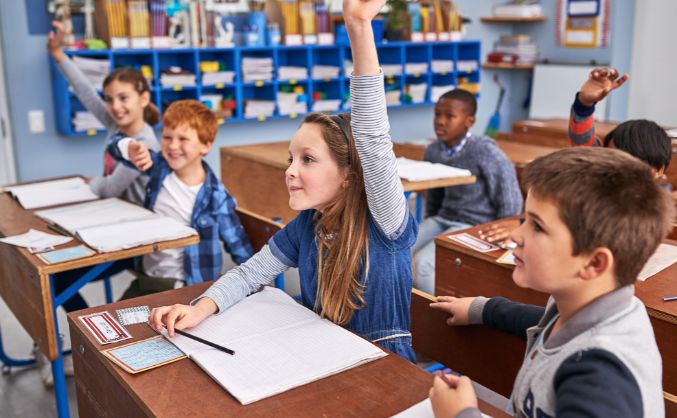Imagine a classroom environment where your child actively participates in discussions and receives individual attention from their teacher. Picture your child feeling comfortable asking questions without hesitation. This isn’t just wishful thinking — it’s the reality for students who know the benefits of smaller class sizes.
Research shows that small class sizes greatly affect a child’s learning experience. Class size may seem minor compared to courses and activities, but it plays a major role in a child’s education.
This blog post explores the benefits of smaller classes. We’ll explain how smaller classrooms can positively influence your child’s academic success, social development, and confidence.
Personal Attention: A Cornerstone for Success
One of the advantages of small class sizes is the individual attention each student receives. With fewer students, teachers can devote more time to a child’s unique needs and learning styles. This personalized approach allows teachers to:
- Identify Strengths and Weaknesses: Teachers can focus on student outcomes because of the student-teacher achievement ratio. Educators can pinpoint specific areas where a child is succeeding or where they need support.
- Tailor Instruction: Understanding a student’s learning style allows the teacher to adapt lessons for visual, auditory, or kinesthetic learners.
- Provide Targeted Support: Class size reduction means that teachers can provide help one-on-one or in small group settings.
Fostering Active Learning
Why are smaller class sizes better than large classes for student engagement? A limited number of students in a classroom can create a more positive learning experience overall. Here’s how:
- Freedom to Participate: Students feel more comfortable raising their hands and participating in discussions with fewer classmates. Active participation is a leading factor in the development of critical thinking skills.
- Lively Classroom Discussions: Limited class sizes also prompt lively student engagement. Students can build on each other’s ideas, ask questions, and explore different views.
- More Collaboration: Teachers can easily add collaborative hands-on learning activities. Students work together on projects and learn to solve problems, building teamwork and communication skills.
This active learning environment keeps students engaged and motivated. As a result, students in smaller classes have a more positive and enriching educational experience.

Building Confidence and Social Skills
The benefits of smaller class sizes in elementary school, middle school, and high school go beyond academic success. Class size also impacts a child’s social and emotional development by creating a more supportive and nurturing environment. Let’s go over a few key examples:
- Stronger Teacher-Student Relationships: Educators can build stronger relationships with children in smaller classrooms. This fosters a sense of trust and belonging, which can significantly impact a student’s confidence and self-esteem.
- Positive Peer Interaction: Limited class sizes allow for more positive peer interactions. Children can develop closer friendships, learn from each other’s social cues, and practice empathy and respect.
- Reduced Stress and Anxiety: Smaller classes are more comfortable for shy or introverted students. The children can focus on learning and feel more comfortable participating in classroom activities.
Class size matters, largely because small classes promote healthy emotional growth. As a result, children develop the confidence and social skills they need to thrive inside and outside the classroom.

The Benefits Span All Age Groups
Not surprisingly, the advantages of smaller class sizes impact various age groups. Research shows that students of all ages, from elementary school to college, benefit from this approach.
In elementary school, limited numbers mean that teachers can provide personalized instruction. They can lay foundational skills — crucial for future academic success.
Smaller classrooms help teenagers navigate challenging coursework in middle and high school. Students benefit from personalized guidance on college prep and develop strong social skills as they enter adulthood.
Many institutions of higher learning also recognize the benefits of small class size in college.
Finding the Right Fit: Bethany School
Bethany School is a co-educational private school in Cincinnati, Ohio, serving students from Pre-K through 8th Grade. We’ve witnessed firsthand the smaller class size benefits: engaged students and a nurturing learning environment. With an average class size of 15 students, we provide personalized attention and support to each child. As a result, children can begin to reach their potential.
Learn More About Bethany School
If you want a school with small classes and personalized learning, check out our website. Explore our curriculum, programs, and admissions process.
Bethany School offers a welcoming and inclusive community that values and supports children. We invite you to contact us to schedule a tour and experience the Bethany School difference firsthand.
Bethany School: Where Curiosity and Confidence Thrive
Frequently Asked Questions
What are the benefits of a co-educational learning environment?
A co-education fosters collaboration, communication, and social development. Students learn from diverse perspectives and develop strong teamwork skills through working together on projects and activities.
Does Bethany School offer extracurricular activities?
Yes! Bethany School offers a variety of extracurricular activities to complement our academic program. These activities allow students to explore their interests, develop new talents, and connect with classmates who share their passions. Options include Theater, Art, Dance, Robotics, Chess Club, Design Lab, Mock Trial, and more.
Does Bethany School integrate technology into the curriculum?
Yes. Bethany School recognizes the importance of technology in education. We integrate technology strategically to enhance learning, encourage creativity, and prepare students for the demands of a digital world. Students use tablets, laptops, and interactive learning tools to research, collaborate, and showcase their understanding.
How does Bethany School support students with different learning styles?
Our dedicated teachers understand that students learn in different ways. We use different teaching methods like visuals, hands-on activities, and personalized instruction to meet each student’s learning needs.
Is financial aid available?
Bethany School recognizes the importance of tuition costs. We offer financial aid to qualified families to make a Bethany School education accessible. We encourage you to contact our admissions office to learn more about financial aid options and the application process.
